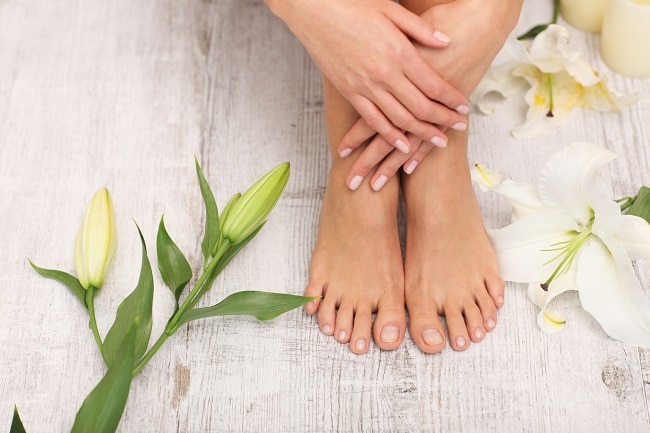Proper nail care is essential. After all, clean, well-groomed finger and toenails are not just part of an attractive appearance; they’re an indicator of overall health. The color and texture of nails can reflect one’s wellbeing—or serve as a sign of conditions such as anemia, kidney disease, lung disease and diabetes.
Are your nails normal?
Finger and toenails are composed of layers of keratin, a type of protein also found in claws, feathers, hair, hooves and horns. Healthy nails are smooth and consistent in color. With age and injury, they may develop vertical ridges, white spots and/or white lines, but these are not usually cause for concern.
However, consult your dermatologist or primary care physician if you notice any of the following:
- A change in the color of nails (e.g., discoloration of entire nail, dark streak beneath nail)
- A change in the shape of nails (e.g., curling)
- A change in the thickness of nails
- Bleeding, swelling or pain around nails
- Separation of nails from surrounding skin
- Stunted nail growth
Nail care tips
Want to achieve and maintain strong, healthy nails? Here’s how:
- Keep finger and toenails clean and dry. This helps prevent bacterial growth. Repeated/prolonged exposure to water can also contribute to splitting of fingernails.
- Trim and shape nails properly. Use clean, sharp clippers or nail scissors to cut your nails straight across, and then round them gently with a smooth file or emery board. Instead of using a back-and-forth motion, file in a single direction to reduce breakage. Keeping toenails short can help minimize the risk of injury and trauma.
- Limit hand washing and exposure to chemicals. Frequent washing and chemical exposure can cause fingernails to become dry and brittle. Wearing household gloves while cleaning, washing dishes or handling harsh chemicals can limit the associated damage. If your profession requires frequent hand washing, be sure to moisturize often (see below).
- Moisturize fingernails regularly. If they are prone to breakage, there’s a good chance they are lacking essential moisture. Whenever your hands feel parched, massage hand lotion into your nails and cuticles, too. Follow with cuticle oil, which can help reduce and prevent nails from chipping and splitting.
- Refrain from biting fingernails and removing cuticles. Both habits can harm your nail beds. Even a small cut alongside your nail can permit bacteria or fungi to enter and trigger an infection. It’s important to note that pushing cuticles back—a common practice—can also cause problems.
- Don’t tear off hangnails. Clip them carefully instead. Otherwise, you run the risk of ripping off living tissue in addition to the hangnail.
- Use nail polish remover less often. And when you do, opt for a formula that doesn’t contain acetone, which can cause nails to become brittle and break.
- Do not use fingernails as a tool. It may be tempting, but try to resist the urge to use your fingernails to peel off labels, open soda cans, etc.
- Take biotin supplements. This B vitamin has been associated with increased nail thickness and strength. Try Vitacost Biotin Capsules, which “are manufactured to high standards of potency, purity, efficacy and safety” and contain no eggs, fish, gluten, milk, peanuts, soy, titanium dioxide or tree nuts.
- Use caution with manis and pedis. Make sure you go to a licensed technician at a licensed salon that uses sterilized tools. Or better yet—bring your own tools! Don’t allow anyone to remove your cuticles (see above) and, if desired, opt for tips over full extensions as they are less likely to cause bacterial or fungal infections.
- Eat nail-boosting foods. What are the best foods for nails? Green veggies, like kale, Brussels sprouts and broccoli, provide vitamins A, C, E and K that help support collagen production and healthy cell function.
Now that you’ve read about nail care, take the next step – literally! Get the scoop on caring for your toes and learn how to make your feet soft.

